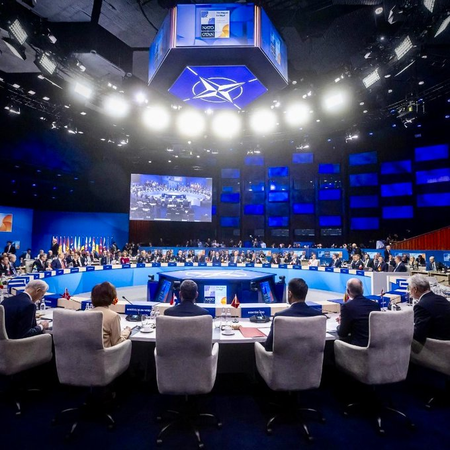
Rome — The recent NATO summit in The Hague (June 24-25) may be remembered not only for its reaffirmations—support for Ukraine, higher defence spending, and condemnation of Iranian attacks—but for its clear, forward-looking strategic shift: the Indo-Pacific now features prominently in NATO’s security vision, especially as the Indo-Mediterranean region faces growing instability.
This marks a significant departure from NATO’s post-Cold War approach, which remained largely Atlantic-focused. Even when NATO ventured beyond, into Afghanistan or Libya, the assumption was that security threats radiated outward from Europe. The idea that Asia could directly influence Euro-Atlantic stability was once dismissed as speculative — that notion no longer holds.
NATO’s Indo-Pacific engagement began before Russia’s 2022 invasion of Ukraine. In the late 2010s and early 2020s, NATO quietly deepened its ties with democratic Indo-Pacific partners — Japan, Australia, South Korea, and New Zealand — eventually formalising cooperation through the "IP4" framework. But Russia's war in Ukraine and Beijing's strategic alignment with Moscow have pushed the Indo-Pacific higher on NATO’s agenda.
In 2022, NATO’s Strategic Concept declared that China’s "coercive policies challenge our interests, security, and values." At The Hague, this stance hardened further — China was labelled not just a systemic rival but a "decisive enabler" of Russia's military efforts.
Still, NATO’s ambitions in the Indo-Pacific are limited by design. The alliance is not trying to become an Indo-Pacific bloc. It cannot and should not replicate its Euro-Atlantic model in Asia. Instead, NATO is pursuing what could be described as "strategic flexibility" — building partnerships, enhancing coordination, and promoting technological interoperability to strengthen deterrence without requiring formal alliances.
This is where India plays a unique role — not as a NATO ally, but as a critical partner.
India remains committed to strategic autonomy and non-alignment. It is not part of the IP4 and has no intention of joining NATO or entering treaty-based defence commitments. India has long avoided bloc politics and maintains deep historical ties with Moscow, even as it diversifies its defence partnerships. But India’s strategic autonomy does not equate to passivity.
In recent years, India has advanced an active Indo-Pacific strategy, exemplified by its SAGAR doctrine — "Security and Growth for All in the Region" — and more recently, the ‘Mahasagar’ initiative, launched in late 2024.
Mahasagar — Sanskrit for "great ocean" — reflects India’s ambition to become the leading force for stability in the Western Indo-Pacific. The initiative combines enhanced maritime domain awareness, defence-industrial cooperation, and coordination on blue economy issues across the Arabian Sea, Bay of Bengal, and African coastlines.
It also promotes interoperability with like-minded navies and the integration of undersea surveillance and cyber capabilities. Though not explicitly targeting any country, Mahasagar clearly counters China’s Belt and Road naval presence in the Indian Ocean.
India’s role in the Quadrilateral Security Dialogue (Quad) — alongside the US, Japan, and Australia — already positions it as a major player counterbalancing China. Yet the Quad is not a formal military alliance; it works through consensus and capacity building.
NATO complements India’s security toolbox differently — offering institutional expertise, shared technical standards, and operational know-how in areas like cyber defence, artificial intelligence, and undersea deterrence. Where the Quad provides strategic alignment of vision, NATO offers alignment of capability.
Examples of this cooperation are already visible. In 2024, India conducted joint exercises with the Italian aircraft carrier Nave Cavour, demonstrating advanced interoperability. India has also participated in multilateral operations such as Sea Dragon, alongside the US, Japan, Australia, and Canada. Meanwhile, NATO has opened channels for integrating defence technologies with regional partners.
At The Hague summit, NATO announced new initiatives in cyber security, counter-disinformation, AI, and dual-use industrial cooperation — all areas where India is expanding its capabilities.
Formal defence pacts or NATO bases in India are not on the table — and rightly so. The focus is on practical, modular collaboration: joint exercises, harmonised technical standards, and secure communications frameworks that allow coordinated responses to maritime instability, cyber threats, and supply chain vulnerabilities.
There’s also a broader strategic rationale for India-NATO cooperation. Trade through the South China Sea and Taiwan Strait is not an abstract concern for Europe. Nearly 40% of global trade passes through these waters. Any conflict, particularly over Taiwan, would disrupt supply chains, raise commodity prices, and destabilise energy markets.
Thus, Euro-Atlantic security is no longer defined by geography but by connectivity. And India, located at the crossroads of East and West, is uniquely positioned to help NATO navigate this new reality.
Importantly, NATO’s appeal to India lies in its respect for New Delhi’s autonomy. What is emerging is not an alliance but a partnership — driven by complementary interests rather than shared identities.
Going forward, NATO must avoid copying its Atlantic model in Asia. Instead, it should embrace a strategy of "flexible geometry" — deeper engagement with the IP4, tailored cooperation with India, and joint projects involving the Quad and the EU’s Indo-Pacific strategies.
For India, this is a chance to influence regional security without compromising independence. For NATO, it is a way to remain globally relevant without overstretching.
The future of global deterrence will hinge less on rigid treaties and more on adaptive, resilient networks. As global alliances shift and new coalitions emerge, NATO and India have a rare opportunity to build one of the century’s most significant security partnerships — one rooted in autonomy, free from entanglements, and anchored in shared strategic imperatives.
With inputs from IANS